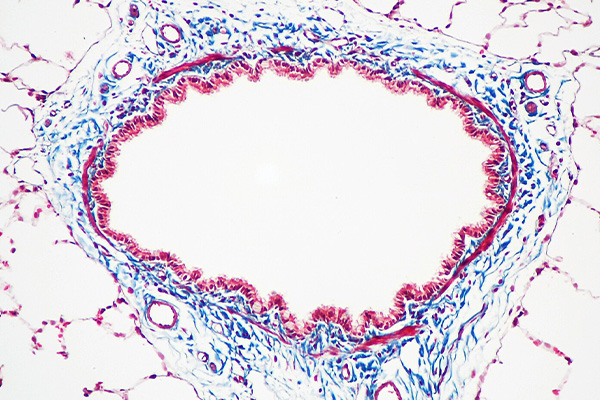Masson's Trichrome
Original Variants
Expected Results
- Nuclei – Black (red if an iron hematoxylin was not used)
- Collagen – blue
- Bone – dark blue
- Epithelia – light red
- Muscle – light red
- Erythrocytes – orange
- Nervous tissue – violet
Materials
- Régaud’s iron hematoxylin or equivalent
- Solution A
Material Var 1 Var 2 Var 3 Var 4 Acid fuchsin 0.5 g 0.35 g – 1.0 g Ponceau 2R – 0.65 g 1.0 g 1.0 g Glacial acetic acid 0.5 mL 1 mL 1 mL 1 mL Distilled water 100 mL 100 mL 100 mL 100 mL - Solution B
Material Amount Phosphomolybdic acid 1 g Distilled water 100 mL - Solution C
Material Amount Acetic acid, glacial 2.5 mL Distilled water 97.5 mL Aniline blue as required Mix the acetic acid and water. Saturate with aniline blue.
- Solution D
Material Amount Acetic acid, glacial 1 mL Distilled water 99 mL - Solution E
Material Amount Acetic acid, glacial 1 mL Ethanol, absolute 99 mL
Tissue Sample
5µ paraffin sections of neutral buffered formalin fixed tissue are suitable. Other fixatives are likely to be satisfactory. Trichrome stains often benefit from initial Bouin or formal sublimate fixation, or from secondary fixation in Bouin’s fluid for an hour at 56°C.
Protocol
- Bring sections to water via xylene and ethanol.
- Optionally, stain nuclei with Régaud’s iron hematoxylin.
- Wash in water.
- Place into one of the variants of solution A for 5 minutes.
- Rinse quickly with water.
- Place into solution B for 5 minutes.
- Drain, but do not rinse with water.
- Place into solution C for 2-5 minutes.
- Place into solution D until differentiated.
- Dehydrate with solution E.
- Clear with salicylic xylene.
- Mount with salicylic balsam.
Notes
- Masson also suggested another method.
- The dye Masson called ponceau 2R is thought to be xylidine ponceau.
- It was originally considered important to mount sections stained with acid dyes in an acidified mounting medium, in the belief that it preserved brightness and clarity.
- Salicylic xylene is made by saturating xylene with salicylic acid.
- Salicylic balsam is made by adding salicylic acid to Canada balsam, then allowing the excess to settle out. The medium should be clear, pale yellow. An alternative is to dip the coverslip into salicylic xylene prior to mounting. The dissolved salicylic acid will then acidify the mounting medium.
Safety Note
Prior to handling any chemical, consult the Safety Data Sheet (SDS) for proper handling and safety precautions.
References
- Gray, Peter. (1954)
The Microtomist’s Formulary and Guide.
Originally published by: The Blakiston Co.
Republished by: Robert E. Krieger Publishing Co.







